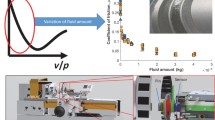Abstract
Solid friction is considered by some to be a fundamental property of two contacting materials, while others consider it to be a property of the larger tribosystem in which the materials are contained. A set of sliding friction experiments were designed to investigate the hypothesis that the unlubricated sliding friction between two materials is indeed a tribosystems-related property and that the degree to which the materials or the machine and its environment will affect the measured friction is also system-dependent. Three tribometers were used: a friction microprobe (FMP), a typical laboratory-scale reciprocating pin-on-flat device, and a heavier, commercial wear tester. The slider material was stainless steel (AISI 440C) and the flat specimen material was an ordered alloy of Ni3A1 (IC-50). A sphere-on-flat geometry was used at ambient conditions and at normal forces ranging from 0.01 N to 100 N and average sliding velocities of 0.01 to 100.0 mm/s. The nominal, steady-state sliding friction coefficient tended to decrease with increases in normal force for each of the three tribometers, and the steady state value of sliding friction tended to increase as the size of the machine increased. The mechanisms for this behavior concern the relative role of oxide layers, roughness generation, and debris particle-trapping. The variation of the friction force during sliding was a characteristic of the stiffness of the test system. These studies support the idea that the frictional behavior of both laboratory and engineering tribosystems should be characterized by more than a single numerical value for friction coefficient at steady-state and that friction models should predict variations in frictional behavior more explicitly by considering system properties. Mechanistically, the present results underscore how the competition between frictional contributions can change under different testing conditions.
Access this chapter
Tax calculation will be finalised at checkout
Purchases are for personal use only
Preview
Unable to display preview. Download preview PDF.
Similar content being viewed by others
References
Blau, P. J. (1991) “Scale Effects in Steady State Friction,” Trib. Trans., Vol. 34, pp. 335–342.
Bowden, F. P. (1957/58) “A Review of the Friction of Solids,” Wear, Vol. 1, pp. 333–346.
Rabinowicz, E. (1957) “Investigation of Size Effects in Sliding by Means of Statistical Techniques,” Proc. of the Conf. on Lubr. and Wear, Instit. of Mech. Engr., London, pp. 276–280.
Blau, P. J. (1991) “Running-in: Art or Engineering?”, J. of Mater. Engrg., Vol. 13, pp. 47–53.
Blau, P. J. (1989) Friction and Wear Transitions of Materials, Noyes Publications, Park Ridge, NJ, pp. 197–267.
Obmae, N. (1980) in Fundamentals of Tribology, ed. N. P. Sub and N. Saka, MIT Press, pp. 201–222.
Samuels, L. E. (1982) Metallographic Polishing by Mechanical Methods, 3rd ed., ASM, Metals Park, Ohio, pp. 123–126.
Ruff, A. W., Ives, L. K. and Glaeser, W. A. (1981) “Characterization of Wear Surfaces and Wear Debris,” in Fundamentals of Friction and Wear of Materials, ed. D. A. Rigney, ASM, Metals Park, Ohio, pp. 235–289.
Blau, P. J. (1979) “A Study of the Interrelationships Among Wear, Friction and Microstructure in the Unlubricated Sliding of Copper and Several Single-Phase Binary Copper Alloys,” Ph.D. dissertation, The Ohio State University, 341 pp.
Evans, A C. and D. B. Marshall, D. B. (1981) “Wear Mechanisms in Ceramics, in Fundamentals of Friction and Wear of Materials, ed. D. A. Rigney, ASM, Metals Park, Ohio, pp. 439–452.
Bartenev, G. M. and Lavrentev, V. V. (1981) Friction and Wear of Polymers, Elsevier, Chapters 3–5.
Blau, P. J. (1990) “Friction Microprobe Studies of Composite Surfaces,” in The Tribology of Composite Materials, ed. P. K. Rohatgi, P. J. Blau, and C. S. Yust, ASM International, Materials Park, Ohio, pp. 59–68.
Blau, P. J. and DeVore, C. E. (1990) “Sliding friction and wear behavior of several nickel aluminide alloys under dry and lubricated conditions,” Trib. Int'l., Vol. 23(4), pp. 226–234.
Bowden, F. P. and Tabor, D. (1986) “The Friction and Lubrication of Solids,” Oxford Science Pub., pp. 119–120.
Wood, G. C. and Chattopadhyay, B. (1980) “Transient Oxidation of Nickel-Base Alloys,” Corrosion Sci., Vol. 10, p. 271.
Godet, M. (1984) “The Third-Body Approach: A Mechanical View of Wear,” Wear, Vol. 100, pp. 437–454.
Berthier, Y., Godet, M., and Brendle, M. (1986) “Velocity Accomodation in Friction,” STLE Preprint No. 88-TC-3A-2.
Heshmat, H. (1991) “The Rheology and Hydrodynamics of Dry Powder Lubrication,” Trib. Trans., Vol. 34, pp. 433–439.
Suh, N. P. (1986), Tribophysics, Prentice-Hall, Englewood Cliffs, New Jersey, pp. 416–442.
Sheasby, J. S. (1981), “Attainment of Debris-Free Dry Wear Conditions,” Proc. ASME Wear of Materials, ASME, New York, pp. 75–81.
Blau, P. J. (1987), “A Model for Run-in and Other Transitions in Sliding Friction,” J. of Trib., Vol. 109, pp. 537–544.
Aronov, V., D’Sousa, A. F., Kalpakjian, S., and Shareef, I. (1984) “Interactions Among Friction, Wear, and System Stiffness-Part 1: Effect of Normal Load and System Stiffness,” J. of Trib., Vol. 106, pp. 54–58.
Aronov, V., D’Sousa, A. F., Kalpakjian, S., and Shareef, I. (1984) “Interactions Among Friction, Wear, and System Stiffness-Part 2: Vibrations Induced by Dry Friction,” J. of Trib., Vol. 106, pp. 59–64 (1984).
Kato, K., Iwabuchi, A. and Kayaba, T. (1982) “The Effects of Friction-Induced Vibration on Friction and Wear,” Wear, Vol. 80, pp. 307–320.
Chiou, Y. C., Kato, K. and Kayaba, T. (1985) “Effect of Normal Stiffness in Loading System on Wear of Carbon Steel-Part 1: Severe-Mild Wear Transition,” J. of Trib., Vol. 107, pp. 491–495.
Author information
Authors and Affiliations
Editor information
Editors and Affiliations
Rights and permissions
Copyright information
© 1992 Springer Science+Business Media Dordrecht
About this chapter
Cite this chapter
Blau, P.J. (1992). Scale Effects in Sliding Friction: An Experimental Study. In: Singer, I.L., Pollock, H.M. (eds) Fundamentals of Friction: Macroscopic and Microscopic Processes. NATO ASI Series, vol 220. Springer, Dordrecht. https://doi.org/10.1007/978-94-011-2811-7_26
Download citation
DOI: https://doi.org/10.1007/978-94-011-2811-7_26
Publisher Name: Springer, Dordrecht
Print ISBN: 978-94-010-5249-8
Online ISBN: 978-94-011-2811-7
eBook Packages: Springer Book Archive




